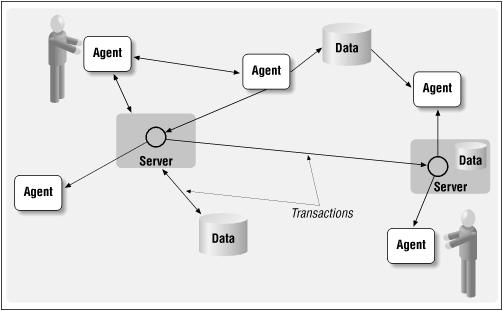 | Java Distributed Computing |  |

What Is a Collaborative System?
Issues with Collaboration
A Basic Collaborative Infrastructure
In this chapter we'll examine the implementation of collaborative systems, a topic that will fuse most of the subjects we discussed earlier in the book. First we'll define what we mean by collaborative systems, and discuss what complications can arise while implementing these systems. Then we'll look at how these issues can be addressed in the Java environment by building a set of base classes that will act as a basic collaboration framework. In the next chapter, we'll present some complete collaborative systems.
A collaborative system is one where multiple users or agents engage in a shared activity, usually from remote locations. In the larger family of distributed applications, collaborative systems are distinguished by the fact that the agents in the system are working together towards a common goal and have a critical need to interact closely with each other: sharing information, exchanging requests with each other, and checking in with each other on their status. In this chapter, we'll consider a collaborative system as one that is also distinguished by a certain level of concurrency; i.e., the agents in the system are interacting with the system and with each other at roughly the same time. So a chat session is collaborative, because all of the agents involved need to coordinate with each other to be sure that the chatters don't miss anyone else's comments. An email system isn't collaborative, because each email client simply wants to be sure that its messages get to the right server, and eventually to the intended recipient. A particular email client doesn't care about the state of any other client, and doesn't need to coordinate with any of them in order to accomplish its goal.
Figure 9-1 depicts some of the elements that can go into a collaborative system:
Autonomous or user-driven agents
Operational and data servers
Dynamic and persistent data repositories
Transactions between agents, servers, and data
Agents, servers, data repositories, and transactions are all elements that make up distributed systems in general, but the nature of the transactions between agents and the shared goals of the agents make a system collaborative.

Here are some examples of what we refer to as collaborative systems:
Shared whiteboards
Interactive chat
Distributed or parallel compute engines
Coordinated data search agents (e.g., web "robots")
The first two involve collaborative agents under the direct control of human beings, while the last two involve agents that are programmed to act autonomously. So a collaborative system can involve concurrent transactions between people, between autonomous computing agents,[1] or some mixture of the two.
[1]Here our use of the word "agent" is much closer to the academic term, e.g., an autonomous computing entity trying to achieve a goal of some kind.

Copyright © 2001 O'Reilly & Associates. All rights reserved.